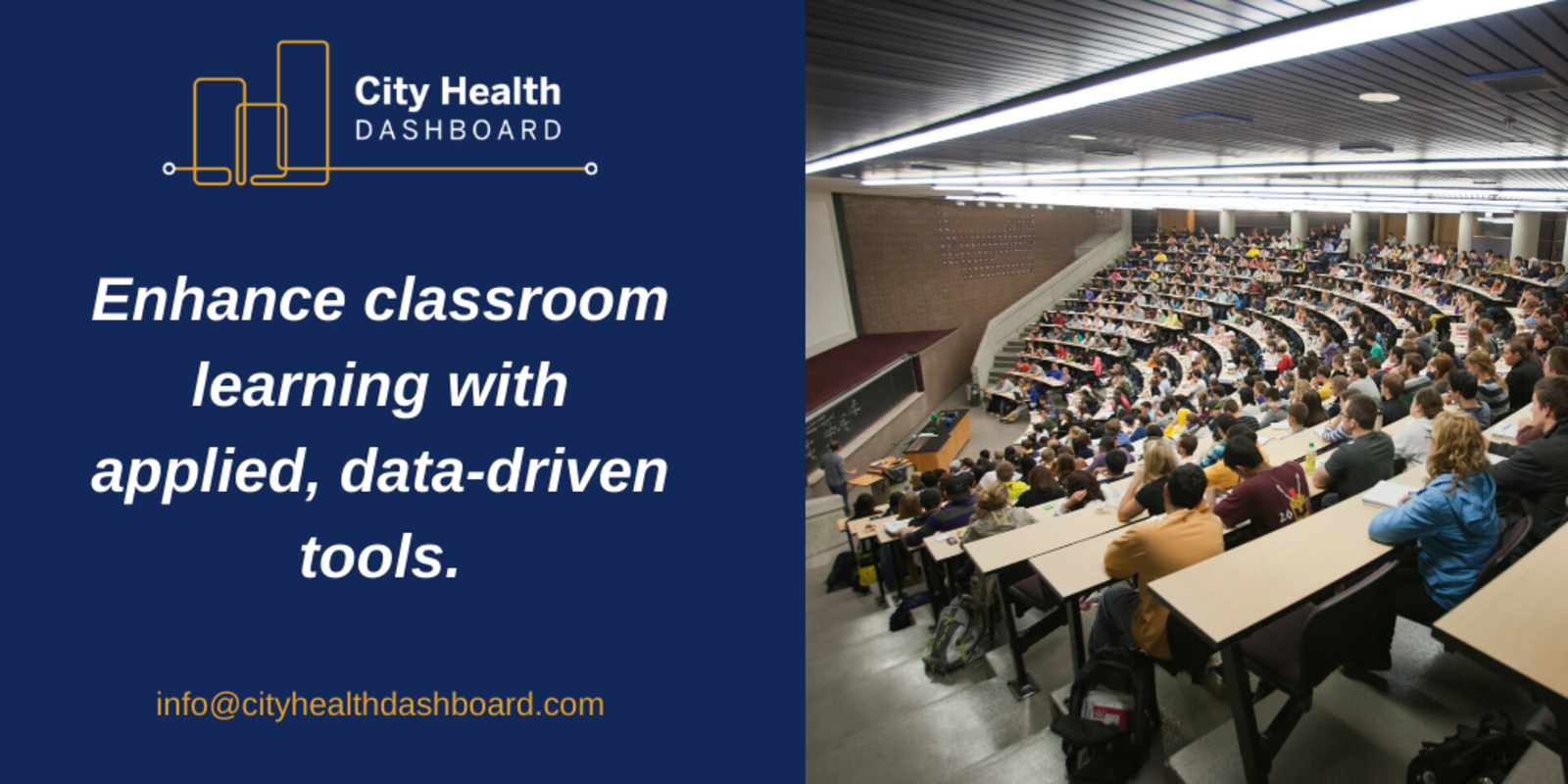City Health Dashboard for Education: Classroom and Virtual Learning
The City Health Dashboard was built for a wide variety of audiences, including educators.
Whether it's Public Health graduate courses, undergraduate Economics classes, or high school Sociology units, the Dashboard is a powerful tool that people of all ages and educational levels can find valuable. We have collected assignments and activities incorporating the Dashboard that educators have used to enhance classroom learning and are sharing them with the hope that other educators can learn from their peers and look to these as examples for their classrooms.
Explore these resources and let us know what's working for you in your classroom!

Featured Resource: High School Lesson Plans
This new mini-curriculum is for high school teachers in a variety of subjects, and includes two multi-day experiences for high school students to engage with the City Health Dashboard data, concepts, and resources. These lessons were designed by teachers and piloted in classrooms across multiple states, grade-levels, and subjects.
type: embedded-entry-inline id: 5w39kaHZbaWsxAUNmopeGA
Lesson One serves as an introduction to the City Health Dashboard tool, giving your students a foothold in the data by focusing on one particular measure of well-being: Broadband Connection (access to high-speed internet).
Lesson Two builds on the skills developed in Lesson One, sending students into a deep dive on the quality of life and well-being for a specific city using Dashboard data.
Both lessons are designed to be flexible in terms of your implementation and are mapped to the Common Core State Standards and AP Human Geography.
This video provides an introductory overview of these new high school resources, and read our blog for more details.
Access the free lesson plans here: from TeachersPayTeachers.com, or from GoogleDrive.
I really love how the lessons got my students more interested in our own city's data.
Erin Parke, pilot classroom teacher
Example Assignments for Undergraduate and Graduate Level Courses
Introduction to the Health Care System – Undergraduate; Rider University
Start at www.cityhealthdashboard.com. Select a city and gather data on a variety of health outcomes and social and economic determinants with the goal of understanding geographic differences of health and wellness. Research past and current city policies there, and tie your findings to upstream factors.
Population Health Management – Undergraduate; Rider University
Visit www.cityhealthdashboard.com Explore health outcomes in a city of your choice. Map outcomes at the census tract level, and create comparisons between different cities with a visualization. Develop a case study where you are the CFO of a hospital in X city tasked with identifying the top health concerns of the population, and strategies to address them to improve the hospital's financial "bottom line."
Health Economics – Undergraduate, Emory University
Visit the City Health Dashboard website. Your goal is to choose a city and describe its within city (sub-city) health inequality profile using health outcomes data. Then, using the Compare Metrics feature, explain this inequality with information the Dashboard provides on social and economic factors, health behaviors, physical environment and clinical care. Make sure to describe the logic of the exercise you are doing and reference appropriate data. Finally, provide one policy solution, based on causal economic research, that could help alleviate the inequality gradient you described (note that it does not need to be a silver bullet solving all problems but rather something that could move the needle).
Business Analytics Senior Capstone course – Undergraduate, Rider University
Using the City Health Dashboard, use data on the built environment in the City of Trenton (specific zip codes tailored to our partner organization/client) and census-tract health outcomes from the City Health Dashboard to identify the built environment's impact on health outcomes.
Foundations of Public Health – Graduate; University of Memphis School of Public Health
Develop a Policy Brief using the City Health Dashboard to assess population needs. Students will use the website www.cityhealthdashboard.com to assess population needs, assets, and capacities that affect communities’ health. Students will also assess the role of social and community factors in both the onset and solution of public health problems. The policy brief, consisting of 1200-1500 words, will identify priorities for a metropolitan city of your choice and should be geared to policy-makers.
Reproductive and Perinatal Epidemiology – Graduate; Rutgers School of Public Health
Select a city of interest on the City Health Dashboard. Explore the city's demographics and metrics, particularly those related to perinatal health and the relevant social drivers we've discussed in class. Prepare a 3-minute lightning talk that gives an overview of your city and the relevant metrics. Be sure your talk covers any interesting historical and demographic context of your city, a clear description of the metrics you've chosen to focus on and why, and how the drivers of health are connected to the perinatal outcome measures you've highlighted.
We would love to hear from you about how you’ve used the City Health Dashboard to educate the rising generation of leaders. If you are a teacher, professor, or student who has used Dashboard data for assignments – please connect with us by clicking here.